Integration, Safety, and Support
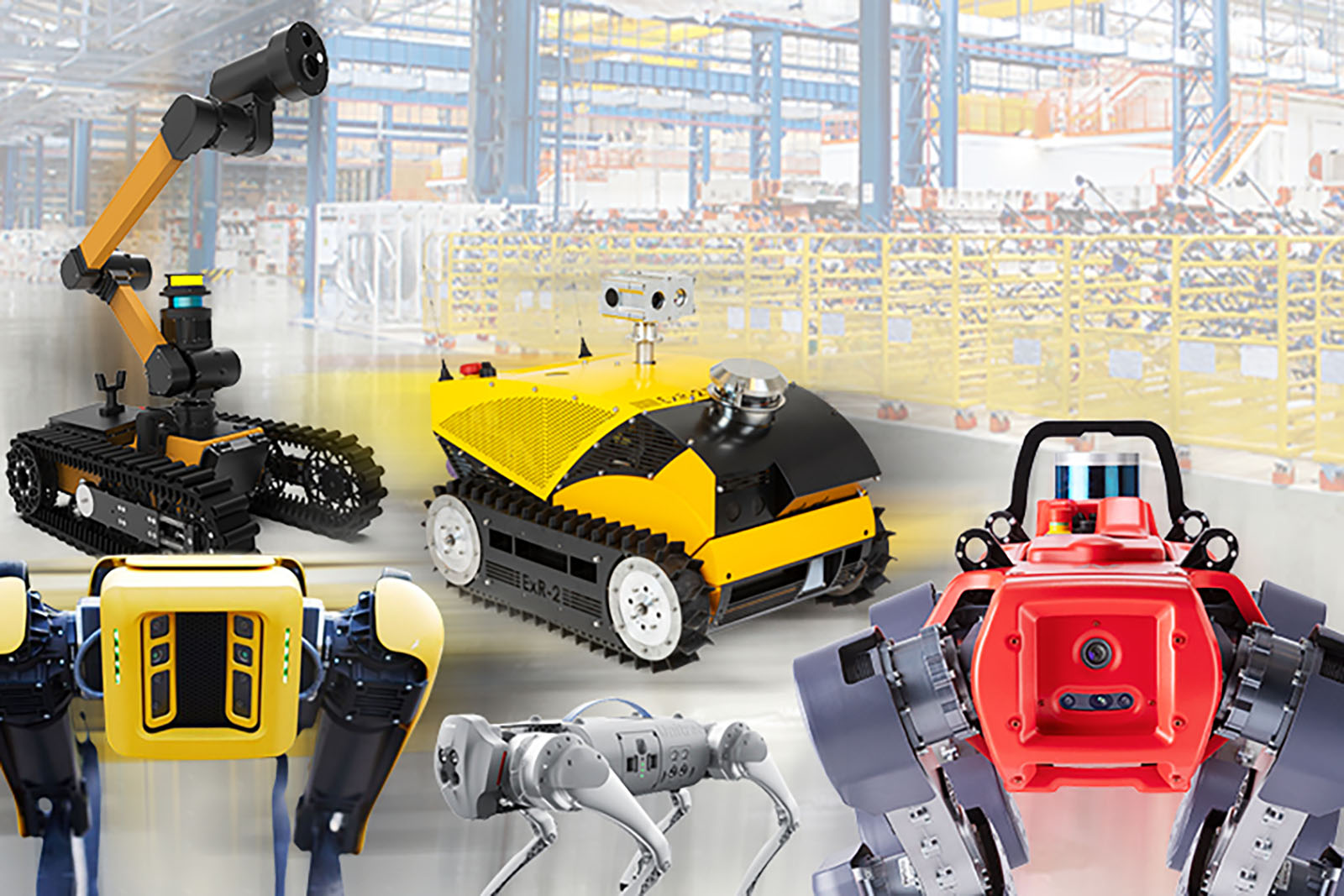
Industrial inspection robots are mobile data-gathering systems. They carry measurement sensors and are designed to navigate facilities built for humans. The usage of this technology is rapidly growing, yet it requires intricate knowledge for new adopters to hire their first inspection robot.
If you are interested in using ground robots to automate industrial inspection jobs in your plant operations, this three-part article series is for you. It will equip you to evaluate different platforms, understand the industrial inspection ecosystem, and make informed decisions around requirements, applications, and suitability. Part one focused on identifying the tasks you want to automate. Part two focused on inspection robots in your operations. Part three focuses on integration, safety, and support.
Integrate the Robotic Solution in Your Operation
Robots add maximal value when they are well integrated into existing operations. When fully integrated, robotic inspection is seamlessly connected to your plant’s operations management systems and requires no manual data processing steps. It also means that the robots can be operated by non-robot experts, which requires high ease of use.
During the qualification of vendors, it’s important to understand the scope of the offered solution and ease of integration. While some solutions are turnkey and can be deployed quickly, others require the overhead of working with third-party payload or software providers.
Can I use my existing digital twin to install an inspection robot?
Digital twin models are a crucial element for the digitalization of industrial plant maintenance. They enable virtual setup and validation of missions remotely before robots are deployed on-site, speeding up the installation of inspection robotics technology. In addition, real-time robot data fed into the digital twin enables operators to intervene quickly and preemptively. The most sophisticated robots can leverage existing digital twins, and update and create new ones.
ANYbotics – Accelerating deployment through digital twins
ANYmal supports the digitalization of operations through scanning and documenting 3D environment data as a digital twin for mission simulations, accelerated deployment, and advanced automated condition monitoring.
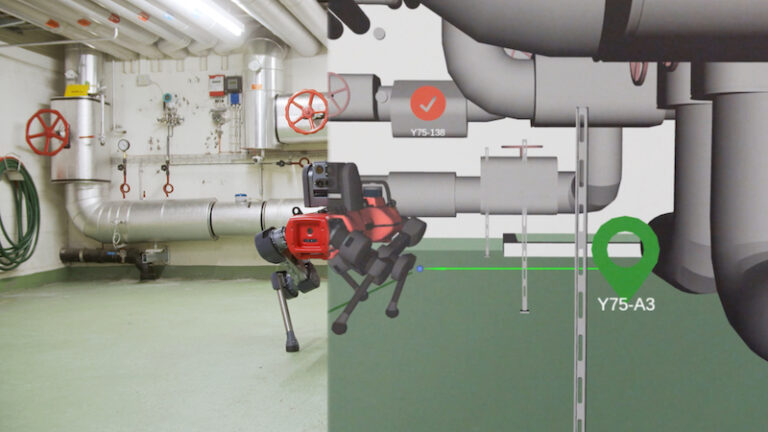
Using BASF’s facility CAD model, ANYbotics is able to pre-program and simulate robotic inspection missions.
What data formats and interfaces do inspection robots provide?
Inspection robot solutions collect large amounts of data. Evaluating the ideal data interface for your operations is essential to leveraging the best insights from the collected information. Typical robotic inspection solutions provide one or multiple of the following data interfaces:
User interface (UI): Direct access and interaction with the inspection results through the UI of the robotic inspection solution. This interface can monitor the progress and results of inspection missions in real-time (provided connectivity with the robot) and study the time series from a sequence of inspection runs.
File exports: Inspection sensor data taken for points of interest includes, for example, images and video sequences for visual and thermal inspection, raw audio files for acoustic recordings, and point clouds for 3D asset scans. Access to raw data is ideal for further analysis and training of predictive models.
Inspection reports: Structured results from complete inspection runs, including information around the inspection analysis (e.g., the values that are read out), identifier, time, position, and other meta information. Inspection reports are often provided as PDF reports for direct consumption and as XML for import into other software.
Can I integrate an inspection robot with my Maintenance Management System?
The inspection data must be integrated into your management systems for inspection robots to function as proper end-to-end solutions. Integration with your maintenance management system, for example, allows you to set up alerts, react to detected anomalies early, and automate end-to-end workflows and preventive maintenance by triggering intervention actions. Integration further enables you to flexibly schedule routine and relevance-based monitoring, including on-demand, conditional, and spot inspections. Effectively integrating inspection data is most commonly achieved through application programming interfaces (APIs).
Software integration via APIs enables deep integration of robotic inspections into existing maintenance management systems. In addition to transferring inspection reports and original files, many APIs also offer the possibility of transferring sensor data in real-time. Inspection robot APIs are typically based on the open source, standardized gRPC API and supported by a software development kit (SDK) in commonly used programming languages, e.g., C++ or Python. The connection to the robot from operator systems can be direct or managed via a robot data server for increased security and reliability. That server can be located on-site at the end user’s facility, in the operator’s cloud infrastructure, or optionally in the solution provider’s cloud infrastructure.
Integrating your inspection data via APIs facilitates consistent inspection data and analysis reports, as well as up-to-date information about the condition of your equipment and infrastructure.
ANYmal – Integrating robots through APIs
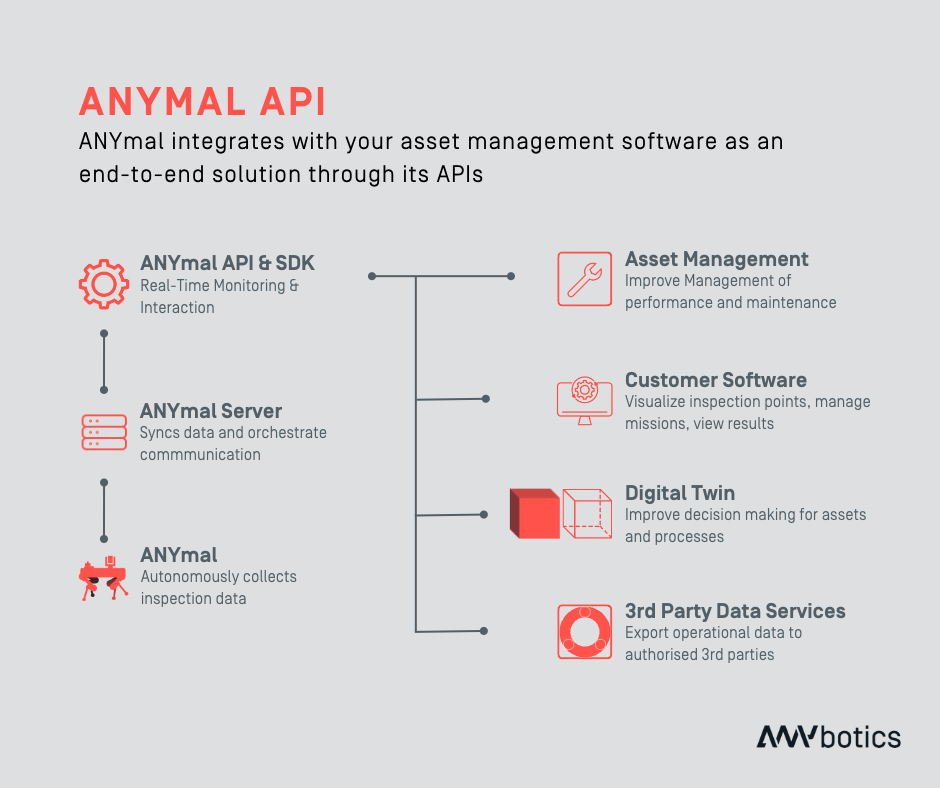
What device do I need to operate the robot?
High usability of inspection robots for non-experts is essential so that operators can set up, manage, and customize inspection jobs without calling in an integrator. Robot control devices and interfaces should fit into your daily work, meaning they should be rugged, waterproof, and able to be operated while wearing gloves. Most robotic solutions offer a standard control device, but the software is ideally device-independent and can be used from existing tablets and computers.
Leading robotic solutions provide a device-independent, intuitive user interface (UI) that allows a single operator to quickly and safely set up, review, and schedule autonomous or manual inspection missions and control the robot. This reduces robot deployment time to less than a day and is highly recommended when scaling inspection robots for broad applications.
ANYbotics Workforce – Intuitive robot control from any device
The intuitive ANYbotics UI Workforce enables any plant personnel to operate ANYmal from any device. Workforce allows operators to set up and review missions, reducing ANYmal deployment time to a few hours.
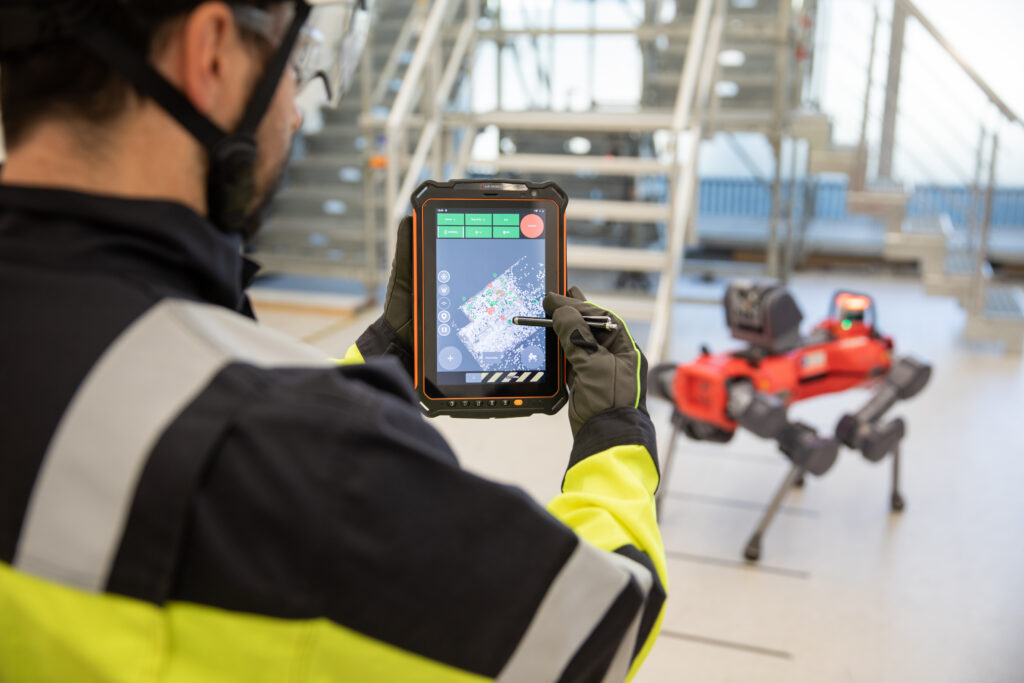
The ANYbotics single-user tablet enables a single operator to set up complex inspection missions quickly.
Don’t Compromise on Safety
Autonomous inspection robotics is a powerful, multidisciplinary technology. During the evaluation process, ensure that the solution meets your safety requirements by paying attention to these three aspects.
Marks and Certification: The CE mark for products that meet EU health, safety, and environmental requirements and FCC certification for electronic components in the U.S. represent basic safety for people and the environment.
IECEx (international) and ATEX (EU) are special certifications for equipment used in hazardous environments and potentially explosive atmospheres.
Operational Safety: Mobile inspection robots move between plant equipment and physical objects, occasionally encountering workers. Full autonomy and extreme mobility are critical, meaning the robot can ‘see’, identify and safely navigate your plant’s infrastructure. Leading inspection robots feature 360° vision, near-depth perception, and obstacle avoidance technology. In addition, these robots visibly communicate their operational status to the environment, e.g., through a red-green warning light system. They are equipped with multiple levels of accessible, certified emergency stop functionality and safety transport handles. Ensure operators do not need special equipment to physically or remotely shut down or move the robot.
To comprehensively address safety, best-in-class solution providers conduct on-site risk assessments in collaboration with end users.
User Training: Reputable robotic solution providers offer comprehensive online and on-site training to familiarize operators with key operating hazards, safety instructions, and emergency shutdown procedures. It is beneficial if they also have an online Learning Management System for retraining new joiners and a Master Operator module that allows your operators to train additional users in your organization independently.
ANYmal – Extending operator assistance
ANYmal and ANYmal X have several standard features that support operators and enable safe operation and transportation.
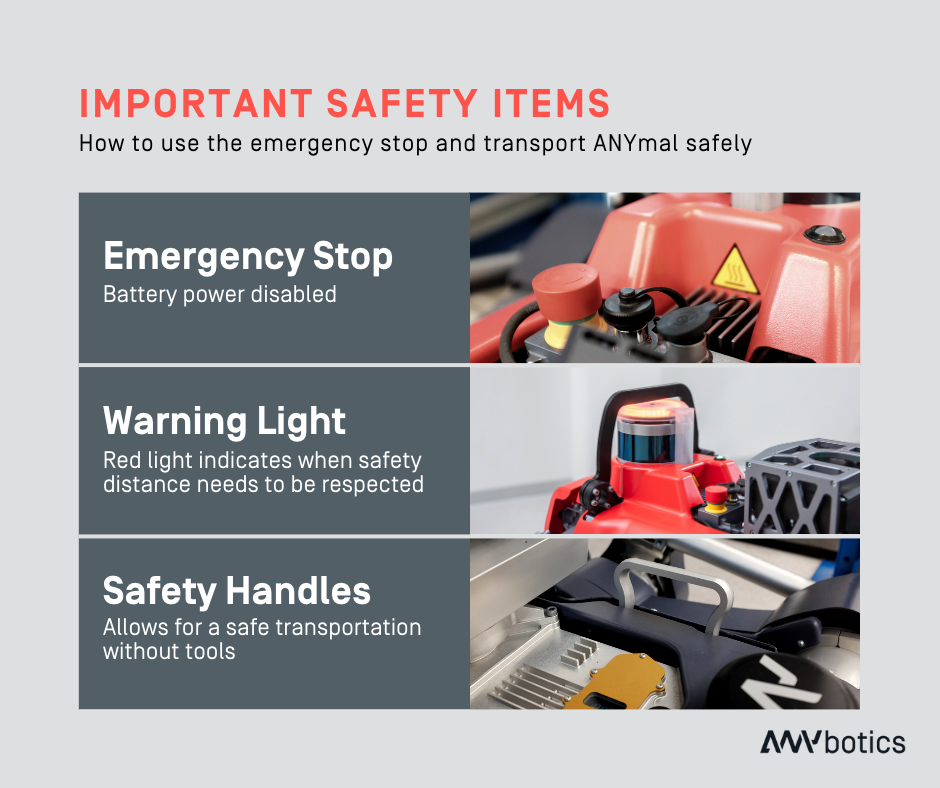
Secure Your Data
An inspection robot generates and collects various data about itself, its operational environment, its missions, and the inspection points on its routes. This data is typically classified into one of two categories, which affects where the data is sent and processed.
Environmental and Inspection data: Includes both data gathered in real-time from its onboard sensors used to understand and navigate its world (e.g., depth camera feeds and Lidar scans) as well as information used by the robot to perform its missions and the gathered inspection data, e.g., mission settings, 3D maps, navigation paths, and inspection results. While most data is discarded immediately, mission and inspection data can be processed and stored on the robot and forwarded to the operator’s computer or end-user systems via the robot API. This means that the inspection output data should only be transmitted to the systems that you as the customer define.
Robot log data: Information about the robot’s activities and its hardware and software performance (e.g., steps taken, battery cycles, software logs, inspection performance). This data is transmitted to the data server and the provider’s systems, where it is stored and processed. The solution provider usually uses this data to further develop the robot solution, improve its services, and also to better fulfill customer support requests.
Integrating data from mobile robotics solutions with your management system via APIs means that the data must be secure and meet your standards for data handling. To avoid data security risks and business disruption due to data loss, integrity, authorization (e.g., GDPR in the EU), or intrusion (i.e., third-party hacking), the robotic platform and solution provider must have effective data security measures in place.
Ensure that the robotics solution provider complies with international information security management standards and implements security programs that ensure risk assessment and security controls. Also, ensure that the vendor communicates with its customers about incidents and threats, handles intermittent and unreliable connections without causing data breaches, and implements regular software and firmware updates to minimize security risks.
What Support Services will I Need?
The core robotic solution is important, but equally important are the support services around the solution that assist you in running the solution smoothly and with high availability. Vendor or reseller support is critical for effective deployment and optimal robotic inspection performance. Leading vendors typically provide comprehensive support through collaboration, on-site consulting, and ongoing solution development. Watch out for resellers who may not have the technical knowledge and resources to provide adequate support. In these cases, working directly with a solution provider is better.
Important support service aspects you should look for when evaluating vendors and resellers include:
Technical expertise: Does the reseller have the necessary technical competence?
Resources: Does the reseller have the resources to provide adequate support at your facility?
Custom engineering: Does the vendor offer hardware and software adaptations to meet your facility’s specific inspection needs better?
Operator training: Will vendor trainers work with your team on operational and maintenance aspects, from onboarding to ongoing deployment support?
Setting-up inspection missions: Can the vendor prepare inspection missions by importing your existing CAD/BIM facility models before the robot arrives?
Post-deployment support: Does the vendor provide a single direct point of communication for on-call troubleshooting and quick response times?
Replacement programs: Does the vendor offer robot or parts replacement programs for defects or robots that need extended repair?
Updates and upgrades: Does the vendor provide software updates and hardware upgrades regularly and, if necessary, remotely?
In-house servicing and repairs: What level of in-house maintenance and repair are you allowed or expected to perform?
Maintenance: What are the maintenance protocols and costs of the robotic solution?
How Should I Acquire the Inspection Robot Solution?
Industrial inspection robotics solutions can be purchased outright or acquired on a subscription basis through Robot-as-a-Service (RaaS). The outright purchase traditionally included the hardware, i.e., the robot, payload, and accessories, as well as the software. To ensure regular software updates, leading vendors now offer the option of purchasing the hardware with licensed Software-as-a-Service (SaaS) or offering the entire system (hardware and software) as RaaS. Each of these options licenses the software, and the licensing fees vary depending on the system’s capabilities. Some organizations still purchase the hardware, but the trend is clearly to acquire the entire system as RaaS.
Outright purchasing is suitable for early innovation projects, such as demonstration systems, and is usually funded from CAPEX budgets, while SaaS software is acquired through OPEX budgets. The inability to lock in future costs (e.g., for customer service) and long approval cycles make this model more suited to pilot projects and initial testing.
RaaS is well suited for operators moving from a pilot phase to full operational deployment. This more modern approach suits organizations with an asset-light strategy that prefer to manage inspection robots through their OPEX budget. Benefits of RaaS include long-term budget clarity, faster approval cycles, quicker access to hardware and software upgrades, and after-sales services.
Which option is the best? The short answer is: it depends. Financial considerations, your company’s digitization strategy, and your inspection automation plan will inform whether it’s best to own or rent robots to perform your needed tasks.
ANYbotics – Flexible robotic inspection solutions
Flexibility and customer success are at the heart of the options ANYbotics offers for purchasing robotic inspection systems. These options allow CAPEX and OPEX alternatives and are among the most advanced in the industry. They include providing the robotic and inspection software as SaaS and either purchasing ANYmal or ANYmal X directly (CAPEX) or renting the complete solution through the RaaS model (OPEX).
Getting Started
Implementing robotic inspection solutions should be a deliberate, step-by-step process. Consider vendor evaluation, deployment aspects, impact on your business, integration with your systems, and broad-scale adoption. By taking a systematic approach, you can maximize the benefits of using inspection robots while avoiding disappointment and setbacks.
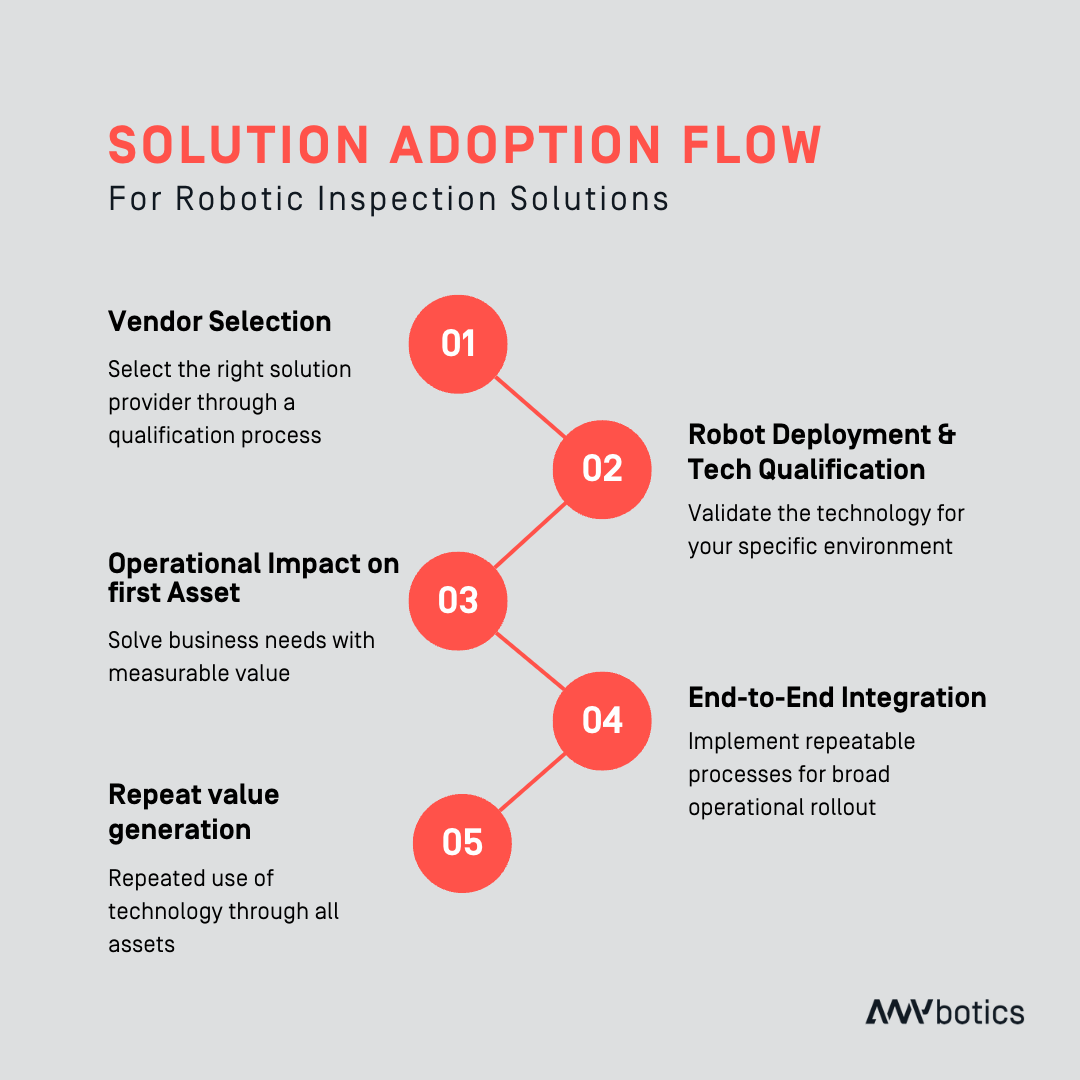
This series of articles is designed to enable you to evaluate different robot platforms, understand the industrial inspection ecosystem, and make informed decisions about your inspection automation needs. The series focuses on three key aspects: the tasks you want to automate, inspection robots in your operation, and integration, safety, and support.
ANYbotics has been working with more than 100 customers worldwide in the oil and gas, chemical, mining, energy, and construction sectors since 2016 and has developed extensive expertise in robotics. ANYbotics provides end-to-end robotic inspection solutions that enable better data collection, facilitate digitization and smart workflows, alleviate customer pain points, improve safety, build robot fleets, and free up human labor.
Contact ANYbotics to learn more about how ANYmal can help you improve operations, increase efficiency and reduce costs.
Article Series
About ANYbotics
Since 2016, Swiss robotics company ANYbotics has developed innovative, intelligent, and integrated robotic solutions that improve workers’ lives, increase productivity, and support more sustainable industrial facilities. Partnering with global technology leaders, ANYbotics provides autonomous, automated, end-to-end robotic inspection solutions, for complex, hazardous, and explosive industrial environments, to large asset operators. ANYbotics is a fast-growing company with over 100 employees focused on supporting the inspection needs of workers in oil & gas, power, energy, mining, processing, chemicals, transportation, and construction.